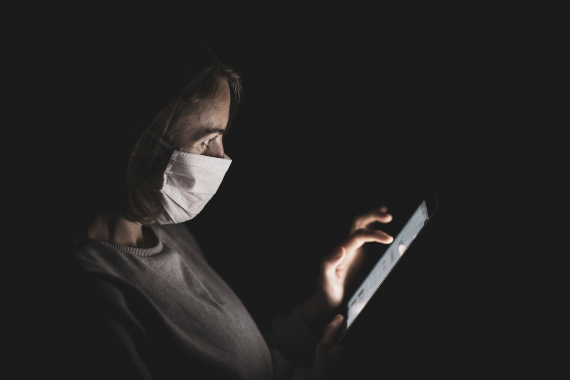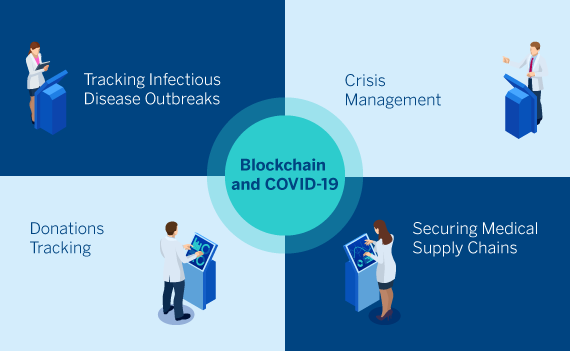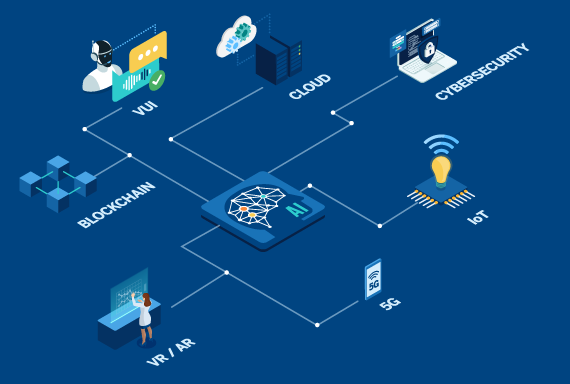COVID-19 has demonstrated the importance of digital readiness, which allows business and people’s life to continue as usual during pandemics. Building the necessary infrastructure to support a digitized world and stay current in the latest technology will be essential for any business or country to remain competitive in a post-COVID-19 world. 3

COVID19 pandemic is the ultimate catalyst for digital transformation and will greatly accelerate several major trends that were already well underway before the pandemic. The COVID-19 pandemic will have a lasting effect not only on our economy, but on how we go about our daily lives, and things are not likely to return to pre-pandemic norms. While this pandemic has forced many businesses to reduce or suspend operations, affecting their bottom line, it has helped to accelerate the development of several emerging technologies. This is especially true for innovations that reduce human-to-human contact, automate processes, and increase productivity amid social distancing. 2
The following technologies stand to bourgeon in a post COVID19 world:
1 Artificial intelligence (AI)
By 2030 AI products will contribute more than $15.7 trillion to the global economy. A number of technological innovations such as intelligent data processing, and face and speech recognition have become possible due to AI. 3
Post-COVID-19, consumer behaviors won’t go back to pre-pandemic norms. Consumers will purchase more goods and services online, and increasing numbers of people will work remotely. As companies begin to navigate the post-COVID-19 world as economies slowly begin to reopen, the application of artificial intelligence (AI) will be extremely valuable in helping them adapt to these new trends. 2
AI will be particularly useful for those within retail and supply chain industries. Through machine learning and advanced data analytics, AI will help these companies detect new purchasing patterns and deliver a greater personalized experience to online customers.
AI tools analyze large amounts of data to learn underlying patterns, enabling computer systems to make decisions, predict human behavior, and recognize images and human speech, among many other things. AI-enabled systems also continuously learn and adapt. These capabilities will be extremely valuable as companies confront and adapt to the next normal once this pandemic subsides. 2
AI will increasingly contribute to the forecasting of consumers’ behavior, which became hardly predictable, and to help businesses organize effective logistics. Chatbots may provide clients’ support 24/7, one of the ‘must-have’ during the lockdown. 3
2 Cloud computing
Fortunately, cloud companies are weathering the pandemic stress-test caused by the sudden spike in workloads and waves of new, inexperienced users. Microsoft reports a 775% spike in cloud services demand from COVID-19. 6
In post-COVID-19 world, cloud technology is likely to receive a surge in implementation across all types of apps. As the virus spread, people were forced to work from home (WFH) and online learning models were implemented, the demand for cloud-based video conferencing and teaching has skyrocketed. Various cloud service vendors have actively upgraded their functions and provided resources to meet this demand. Moving forward, businesses and educational institutions are likely to continue to make use of this technology. As demand for this technology continues to grow, implementation of this technology into mobile applications for easier access will be key, for the cloud the sky is the limit. 2
3 VR/AR
This pandemic increased the number of people using VR headsets to play video games, explore virtual travel destinations and partake in online entertainment, as they isolate at home, they’re also using this technology to seek human interaction through social VR platforms.

Businesses have also been experimenting with VR platforms to train employees, hold conferences, collaborate on projects, and connect employees virtually. For example, scientists worldwide have turned to VR platform for molecular design, to collaborate on coronavirus research and potential treatments. Now that businesses and consumers know the extent to which this technology can be used, we are likely to see more virtual conferences and human interactions as our new normal sets in. 2
4 5G Networks
5G is acknowledged as the future of communication and the cutting edge for the entire mobile industry. Deployment of 5G networks will emerge between 2020 and 2030, making possible zero-distance connectivity between people and connected machines. This type of mobile internet connectivity will provide us super-fast download and upload speeds (five times faster than 4G capabilities) as well as more stable connections. 3
The industry buzz surrounding 5G technology and its impact on the next-generation of connectivity and services has been circulating over the last year or so. Yet, the technology still isn’t widely available and it holds the potential to revolutionize the way mobile networks function, because of COVID-19, the 5G market may materialize sooner than expected. As large numbers of people have been forced to isolate, an increase in working and studying from home has been stressing networks and creating higher demand for bandwidth. People have now realized the need for faster data sharing with increased connectivity speeds, an acceleration in the rollout of 5G technology to ensure the bandwidth and capacity challenges of existing infrastructure is more real than ever. 2

As consumers are becoming increasingly concerned that their mobile devices (which are touched more than 2,600 times per day) can spread coronavirus. As the fear of spreading germs grows, so will the use of voice tech in forms of voice user interface (VUI) , which can reduce the number of times one touches any surface, including our mobile devices. Almost 80% of our communications done using verbal communication, that’s why voice usage will continue to increase and extend to other smart-home components implicated as major germ hubs. As more TVs and entertainment components, light switches, appliances, plumbing fixtures, and alarm systems incorporate voice control functionality, there will be less need to touch them.
Internet of Things (IoT)
IoT will enable us to predict and treat health issues in people even before any symptoms appear, with smart medication containers, IP for every vital part of your body for the doctor to hack. to smart forks that tell us if the food is healthy or not. Personalized approaches concerning prescribing medicines and applying treatments will appear (also referred to as precision medicine). In 2019 there were about 26 billion IoT devices and it’s estimated by statista.com that their number will increase to 30.73 billion in 2020 and to 75.44 billion in 2025. The market value is about $ 150 billion with estimated 15 IoT devices for a person in the US by 2030.
IoT also fuels edge computing, thus data storage and computation become closer to the points of action, enabling saves in bandwidth and low latency. IoT will transform the user experience profoundly, providing opportunities that weren’t possible before. Gaining this experience may be forced by the pandemic, when people are spending almost all their time at home. IoT devices, that make life quality better and daily life more comfortable can become quite trendy. For example, telemedicine and IoT devices helping to monitor people’s health indicators may increase their popularity. 3
Cybersecurity
Cybersecurity is one of the vital technologies for organizations, especially whose business processes are based on data-driven technologies. Much more attention is being paid to privacy and data protection since the European Union’s General Data Protection Regulations (GDRP) has been signed and recently CCPA in California.
During COVID19 pandemic lock-down, when thousands of people are forced to work remotely, volumes of private data may become totally vulnerable or at least not protected in a proper way. This emerging challenge may give another incentive to the Implementation of cybersecurity practices. Cybercriminals took advantage of the fear factor of this virus to send their own viruses, there are many examples of such activities recently including fake domains of COVID19, phishing emails promising virus protection kits and even info about canceled summer Olympic games. In addition there is an increase in ransomware attacks on health institutions and even hacking of research centers to steal any info about possible vaccine of COVID19. 3
Blockchain Technology
The COVID-19 crisis has revealed a general lack of connectivity and data exchange built into our global supply chains. Future resiliency will depend on building transparent, inter-operable and connective networks. If there were any lingering doubts over the value of blockchain platforms to improve the transparency of businesses that depend on the seamless integration of disparate networks, COVID-19 has all but wiped them away. We should look at this healthcare crisis as a vital learning curve that can show us how to build transparent, inter-operable and connective networks. Blockchain is supporting efforts around the globe to battle the virus as explained in the following list 4:

1. Tracking Infectious Disease Outbreaks
Blockchain can be used for tracking public health data surveillance, particularly for infectious disease outbreaks such as COVID-19. With increased blockchain transparency, it will result in more accurate reporting and efficient responses. Blockchain can help develop treatments swiftly as they would allow for rapid processing of data, thus enabling early detection of symptoms before they spread to the level of epidemics. Additionally, this will enable government agencies to keep track of the virus activity, of patients, suspected new cases, and more. 5
2. Donations Tracking
With the help of blockchain capabilities, donors can see where funds are most urgently required and can track their donations until they are provided with a verification that their contributions have been received to the victims. Blockchain would enable transparency for the general public to understand how their donations have been used and its progress. 5
3. Crisis Management
Blockchain could also manage crisis situation. It could instantly alert the public about the Coronavirus by global institutes like the World Health Organization (WHO) using smart contracts concept. Not only it can alert, but Blockchain could also enable to provide governments with recommendations about how to contain the virus. It could offer a secure platform where all the concerning authorities such as governments, medical professionals, media, health organizations, media, and others can update each other about the situation and prevent it from worsening further without censorship. 5
4. Securing Medical Supply Chains
Blockchain has already proven its success stories as a supply chain management tool in various industries; similarly, Blockchain could also be beneficial in tracking and tracing medical supply chains. Blockchain-based platforms can be useful in reviewing, recording, and tracking of demand, supplies, and logistics of epidemic prevention materials. As supply chains involve multiple parties, the entire process of record and verification is tamper-proof by every party, while also allowing anyone to track the process. 5
Ahmed Banafa, Author the Books:
Secure and Smart Internet of Things (IoT) Using Blockchain and AI
Blockchain Technology and Applications
References
2 https://clearbridgemobile.com/five-emerging-mobile-trends-in-a-post-covid-19-world/
3 https://www.sharpminds.com/news-entry/the-future-of-it-covid-19-reality-5-technology-trends/
5 https://medium.com/datadriveninvestor/blockchain-technology-and-covid-19-c504fdc775ba

Comments on this publication